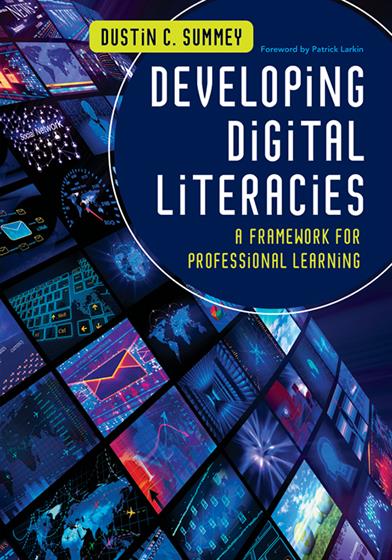Foreword, by Patrick Larkin
Preface
Acknowledgments
About the Author
1. New Literacies in a Digital World
Literacy
Defining Digital Literacies
Standards
The Digital Literacies
Emergent Literacies
Computer Literacy
Cultural Literacy
Game Literacy
Media Literacy
Multimedia Literacy
Network Literacy
Social Literacy
Visual Literacy
Web Literacy
Multiliteracies
Information Literacy
New Literacies
Digital Literacy
Commonalities among Emergent Literacies
The Five Digital Literacies
Locating and Filtering
Sharing and Collaborating
Organizing and Curating
Creating and Generating
Reusing and Repurposing
Memes
Digital Literacies in the Context of Teaching and Learning
Questions for Reflection and Discussion
2. Professional Development That (Really) Works
Standards
Part One: Characteristics of Effective Professional Development
Job-Embedded
Well-Planned
Differentiated
Cohesive and Ongoing
Common Problems and Pitfalls
Technical Issues
Logical Issues
Affective Issues
A Concise, Step-Wise Approach
Planning
Marketing
Implementation
Follow-Up
Part Two: Professional Development Models, Formats, and Approaches
Conferences
Virtual Conferences
Seminars
Workshops
Presentations
Professional Learning Communities
Peer Mentoring
Self-Directed Activities
Creative Approaches to In-House Professional Development
Summer Academy
Mini-Conference
Unconference
After-School Cohorts
Lunch-n-Learn / Prep-Period Tune-Ups
Webinars
Online/On-Demand (“On-Your-Own”)
Podcasts
Learning Bursts
Teachlets
Hosting Content
Mobile Learning (“On-the-Go”)
Conclusion
Questions for Reflection and Discussion
3. A Framework for Program Development and Implementation
Needs Assessment
Creating the Survey
Timing Is Key
Delivery Method
A Modular Approach
Faculty Seminars
Professional Learning Communities
Experimenting: Play Is Okay
Collective Knowledge
Reflecting
Pursuing Results
Peer Mentoring
Assessment
Self-Study
Personal Learning Networks
Individual Classroom Integration
Individual Consultations & Training and Support Resources
Program Timeline
Program Evaluation
Session Evaluations
Midpoint and End-of-Year Surveys
PLC Share-Out Days
Building on the Best
Emerging Leaders
Questions for Reflection and Discussion
Chapter 4 Teacher Leaders and Support Structures
Layers of Support
Administrative Support and Resources
Program Coordinator
Planning
Large-Group Training
Train the Trainer
Participant Leaders
Support Site
Individualized Support
Looking for Leaders
Opinion Leaders
The Three L’s of Leadership
80/20 Principles
Developing a Personal Learning Network (PLN)
Questions for Reflection and Discussion
Chapter 5 Promoting Buy-In and Active Participation
Making the Positive Pitch
Common Challenges
Time and Scheduling
Apathy and Burnout
Poor Quality and Lack of Substance
Marketing Your Program
Creating a Brand for Your Program
Advertising
Publicity
Public Relations
Making the Sale
The Importance of Relationships
Leveraging Intrinsic Motivation
Breaking Down Barriers
Incentivizing Teacher Participation
How to Tank a Teaser
Door Prizes
Instructional Materials
Release Time
Salary Schedule Advancement
Mini-Grants
Presenter Compensation
Making the Connection to the Classroom
Questions for Reflection and Discussion
Chapter 6 Long-Term Planning: Ensuring a Lasting Impact
An Embedded Approach
Resources and Support
Professional Growth Plans
Accountability
Faculty Turnover, Base Training, and Recalibration
Personal Learning Networks
The Plan
Tracks and Strands
Recognition Programs
Developing a Digital Literacies Action Plan
Questions for Reflection and Discussion
Chapter 7 The Tools of Technology
Locating and Filtering
What Is It?
Information and Communication Technologies (ICTs)
Related Tools
Examples in Teaching and Learning
Sharing and Collaborating
What Is It?
Information and Communication Technologies (ICTs)
Related Tools
Examples in Teaching and Learning
Organizing and Curating
What Is It?
Information and Communication Technologies (ICTs)
Related Tools
Examples in Teaching and Learning
Creating and Generating
What Is It?
Information and Communication Technologies (ICTs)
Related Tools
Examples in Teaching and Learning
Reusing and Repurposing
What Is It?
Information and Communication Technologies (ICTs)
Examples in Teaching and Learning
Related Tools
Mobile Learning
Digital Literacies Integration Plan
References
Index



